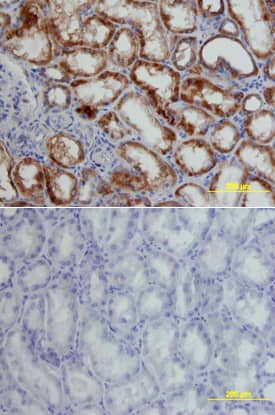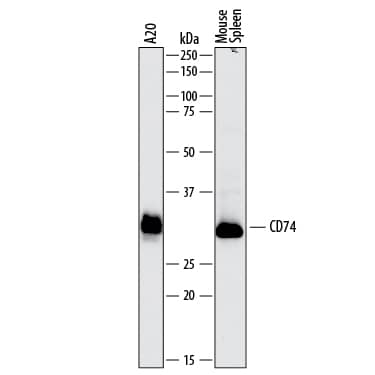Recombinant Mouse Ephrin-A4 Fc Chimera Protein, CF Summary
Product Specifications
| Mouse Ephrin-A4 (Leu26 - Gly176) Accession # Q3UQB5 |
DIEGRMD | Human IgG1 (Pro100 - Lys330) |
| N-terminus | C-terminus | |
Analysis
Customers also Viewed
Product Datasheets
Carrier Free
CF stands for Carrier Free (CF). We typically add Bovine Serum Albumin (BSA) as a carrier protein to our recombinant proteins. Adding a carrier protein enhances protein stability, increases shelf-life, and allows the recombinant protein to be stored at a more dilute concentration. The carrier free version does not contain BSA.
In general, we advise purchasing the recombinant protein with BSA for use in cell or tissue culture, or as an ELISA standard. In contrast, the carrier free protein is recommended for applications, in which the presence of BSA could interfere.
569-A4
| Formulation | Lyophilized from a 0.2 μm filtered solution in PBS. |
| Reconstitution | Reconstitute at 200 μg/mL in sterile PBS. |
| Shipping | The product is shipped at ambient temperature. Upon receipt, store it immediately at the temperature recommended below. |
| Stability & Storage: | Use a manual defrost freezer and avoid repeated freeze-thaw cycles.
|
Background: Ephrin-A4
Ephrin-A4, also known as LERK-4 and EFL-4 (1), is a member of the ephrin ligand family which binds members of the Eph receptor family. All ligands share a conserved extracellular sequence, which most likely corresponds to the receptor binding domain. This conserved sequence consists of approximately 125 amino acids and includes four invariant cysteines. The A-class ligands have a GPI anchor following the conserved sequence. Ephrin-A4 has been shown to bind EphA2, EphA3, EphA4, EphA5, EphA6, EphA7, and EphB1 (2, 3). The extracellular domains of human and mouse Ephrin-A4 share 80% amino acid identity. Only membrane-bound or Fc-clustered ligands are capable of activating the receptor in vitro. While soluble monomeric ligands bind the receptor, they do not induce receptor autophosphorylation and activation (2). In vivo, the ligands and receptors display reciprocal expression (3). It has been found that nearly all receptors and ligands are expressed in developing and adult neural tissue (3). The Eph/ephrin families also appear to play a role in angiogenesis (3).
- Eph Nomenclature Committee [letter] (1997) Cell 90:403.
- Flanagan, J.G. and P. Vanderhaeghen (1998) Annu. Rev. Neurosci. 21:309.
- Pasquale, E.B. (1997) Curr. Opin. Cell Biol. 9:608.
Citations for Recombinant Mouse Ephrin-A4 Fc Chimera Protein, CF
R&D Systems personnel manually curate a database that contains references using R&D Systems products. The data collected includes not only links to publications in PubMed, but also provides information about sample types, species, and experimental conditions.
2
Citations: Showing 1 - 2
Filter your results:
Filter by:
-
EphA4 receptor is a novel negative regulator of osteoclast activity.
Authors: Stiffel V, Amoui M, Sheng M, Mohan S, Lau K
J Bone Miner Res, 2014-04-01;29(4):804-19.
Species: Mouse
Sample Types: Whole Cells
Applications: Bioassay -
Notch signaling coordinates the patterning of striatal compartments.
Authors: Mason HA, Rakowiecki SM, Raftopoulou M, Nery S, Huang Y, Gridley T, Fishell G
Development, 2005-08-24;132(19):4247-58.
Species: Mouse
Sample Types: Whole Tissue
Applications: IHC-Fr
FAQs
No product specific FAQs exist for this product, however you may
View all Proteins and Enzyme FAQsReconstitution Buffers
Reviews for Recombinant Mouse Ephrin-A4 Fc Chimera Protein, CF
There are currently no reviews for this product. Be the first to review Recombinant Mouse Ephrin-A4 Fc Chimera Protein, CF and earn rewards!
Have you used Recombinant Mouse Ephrin-A4 Fc Chimera Protein, CF?
Submit a review and receive an Amazon gift card.
$25/€18/£15/$25CAN/¥75 Yuan/¥2500 Yen for a review with an image
$10/€7/£6/$10 CAD/¥70 Yuan/¥1110 Yen for a review without an image









